
 |
The Heritage Park - Pitstone Green Museum
|
|||||||
| Home | Visit Us | Society | History | Explore | Tickets | News | Contact | |

This area derives it's name from a large Hay Rick which used to stand on the tree line.



The Big Barn is much earlier than the existing farmhouse and dates from the seventeenth century. Note in particular the construction of the roof and the height of the barn. The barn was used for storing sheaves of corn, cut during the autumn and thrashed to remove the grain during the winter months. The barn was filled to the roof and the doors high up on the outer wall were used when the lower levels were filled. If you look carefully you can still see the marks of hayforks on the high cross beams, made when the sheaves were piled to the top.
Within the barn, on the left hand side are two alcoves with doors that lead to the outside yard .Within these alcoves, and extending across the width of the barn, were two wooden threshing floors .These were raised up some two feet above floor level. Threshing of the corn was carried out by hand on these floors, using flails, during the winter months to extract the grain from the cut corn. The remaining straw was used in the yard outside the alcove doors to feed and litter cattle kept there during the winter months. Hand operated winnowing machines were used to blow and sieve out the unwanted chaff and weed seeds from the grain afterwards.
The barn now houses a display of implements and carts, many of which were actually used on the farm. The carts, wagons and some of the artefacts have been, or are being restored, by the society volunteers.
The big barn is also houses a limited number of Craft Stalls on our major Open Days. Tables are available for hire, for prices and availability please contact craftstalls@pitstonemuseum.co.uk. Further information can be found here.



The far end of the Big Barn is called the Mill Barn. Here two grain mills are housed. These are driven by electric motors housed on the floor above. Recently the mechanism has been restored and now shows the mill running as it would have in 1950's. The grain feed has been left off to show the actual mill stone.
The Archaeology display is located in one of the alcoves of the Big Barn. From 1937 until 1991 Pitstone was dominated by the Cement Works. The opening up of the quarries associated with the works created a wonderful opportunity for exploration of the archaeology of an area close to the Ridgeway, which is one of the oldest roads in England. The area was known to have been inhabited for thousands of years.
The archaeological collection consists of items recovered by the Pitstone Local History Society during the 1960's and 1970's. Traces were found of occupation from the earliest times, through the Bronze age and into the Roman period. The society has many examples of fossil remains of plants and animals, including a mammoth tooth. From Roman times there are finds from two sites in the quarries and from c1800 to modern times there is a collection of bottles. All exhibits were found within five miles of this museum.

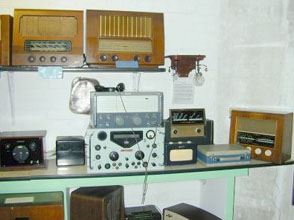
Radio waves were first identified at the end of the 1800's but it was Marconi that turned them from a scientific curiosity into a commercial success. The first transmitters simply consisted of a very powerful spark generator connected to an aerial. This system generated a signal similar to that produced by lightning. It was used to transmit Morse code, a series of dots and dashes that represented numbers & letters of the alphabet. With the development of the valve, a single frequency waveform could be transmitted, rather that the wideband signal generated by a spark. This signal could be then be modulated with an audio signal allowing speech and music to be sent.
The first commercial radio stations appeared in the early 1920's. Many of the first wireless sets were made by amateurs due to the high cost of commercial sets. Many early engineering and wireless hobbies magazines carried plans for building your own sets and due to the simplicity of these early sets construction was well within the capability of DIY enthusiasts of the day. Crystal sets were very popular even though they could only drive a pair of headphones. They used no batteries (which were very expensive in those days) deriving their power directly from the aerial. They could be made with only a few simple components and a piece of crystal (Galena) that was capable of rectifying or changing the high frequency radio waves into the audio component of the signal that could be heard on the headphones. The Vintage Radio Room has exhibits that cover the whole spectrum of early radio up to the 1950's together with photographic and household electrical items.
The first experimental television station appeared in the 1930's, using the Baird 30 line mechanical apparatus. Baird continued with his experiments when in 1935/36 two standards were transmitted, one the Baird 240 line and the other the Marconi 405 line. Due to an unfortunate fire and the more advanced Marconi system, the Baird one was dropped and the Marconi system became the black and white standard adopted until colour arrived. The museum has a rare and unusual 1936 receiver that could be switched between the 240 line baird and the 405 line marconi. It is in working condition but of course there are no commercial stations now transmitting those signals.
Our extensive collection of home computers now resides in this room, dating from the Sinclair Z80 series just about the first computer designed for the home market. Recently revamped with new working computers on display including video games to play.

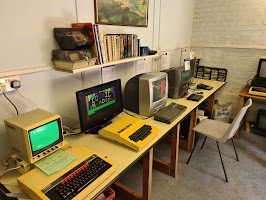


The Museum Shop is also home to our Lace Makers
"A piece of lace is an artistic composition expressed in twisted thread" Miss C. C. Channer, 1900
Lace making came to Britain in the mid 1500s from Belgium as the result of religious persecution of Protestants by Phillip II. These good people arrived in Cranfield, Bedfordshire in 1568 spreading quite quickly into Buckinghamshire( Newport Pagnall, Olney & Buckingham) There being a demand for lace, an industry formed in Northants, Bucks. & Beds.
Lace making was essentially a cottage industry with the people selling the lace to Dealers. The industry thrived to the extent that Lace Schools were set up to teach children. Many lace makers became blind in old age but were still able to make the family lace patterns; almost as if they were machines! Machines killed the handmade lace industry when they were introduced in Nottingham in the late 1800's
Today lace making is a thriving hobby with many clubs around the country. It has "gone modern" to some extent but many traditional patterns are still used. Demonstrations and displays of lace making are a regular feature of our open days. There is always a practice pillow so why not come and have a look and have a go. You will find the Lace Makers hard at work in the museum shop.



The large barn, known as the 'New Grain Barn' now houses the museums collection of the larger items of farm machinery. Over the years various buildings at Pitstone Green Farm have been used for storing grain. Originally the Big Timbered Barn was used for storing the cut corn which was thrashed during the winter months. When in the 20th century machinery arrived like the Combine Harvester, the grain had to be stored and dried in very large containers as production rates increased.
This "New Grain Barn" was the last and biggest used on the museum site and the low tunnel alongside the building ducted warm air from very large fans and heaters through the grain. The remains of large concrete drainage pipes also carried this warm air under and into the grain bins now used as the science room. The massive red Threshing Box predates the Combine Harvester and was used to thrash the cut corn to remove the grain. It has been used in the last few years for filming work on the film 'My Uncle Silas' The Chaff Cutter, in the corner of the building was driven by a tractor and used to cut the lengths of straw remaining after the grain was removed into short lengths, only a centimeter or two long, for adding to the animal feed during the winter months.
The Dickins wagon would have been pulled by horses and is shown attached to a hay rake. The rake was pulled behind the wagon and as it was pulled along, it picked up the hay, already cut, which then went onto the elevator of the rake, depositing the hay into the wagon. Also in the barn is an Elevator that was used to carry straw and hay up to the top of the ricks when they were being built, a Reaper/Binder used to cut and tie the corn into sheaves prior to the introduction of the Combine harvester and other artefacts relating to harvesting and haymaking.

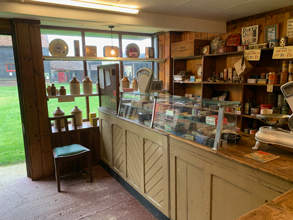
The "Elliotts" shop in Ivinghoe has been reproduced and constructed using the original shop fittings.
The Nissen hut, in which the Dairy, the Old Curiosity Shop and WAGS Wharf are housed, was acquired after WWII when many such buildings were military surplus and erected on the present museum site. It had remained as a store room for many years but during 2004 it was completely refurbished, a concrete floor laid and fitted out as you see it today.

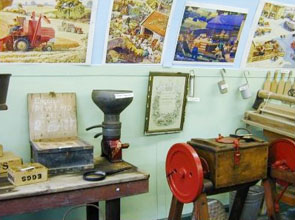
The farm originally contained its own dairy at the north east end of the Farm house, in the coolest possible position. The products of the dairy were used mostly for consumption on the farm. In the early years the work force would have been quite considerable, with unmarried men 'living in' at the farm house. The room has a selection of implements that would have been used in the dairy for making the various dairy products.
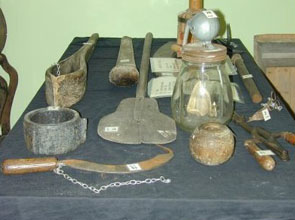

Over the years we have found many unusual items in the museum stores, some we know about and the others we are not sure what they were used for. We have created within the restored WWII Nissen Hut, alongside the dairy, several tables displaying many of these artefacts for visitors to guess what they are, or in some cases to let us know what they were used for, if anyone knows. Lists of what we think the items were used for are provided for visitors to check on their knowledge.
The Nissen Hut is also home to WAGs Wharf, a very detailed and working model layout.

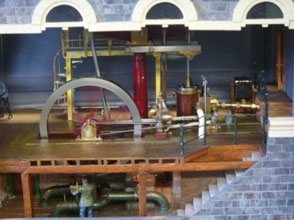

A Model in SM32, Track Gauge ~ 32mm, Scaled at 16mm to the foot, WAGs Wharf represents a small canal spur wharf probably built in the late 1800's on the now derelict Wendover arm of the Grand Junction canal.
The wharf was built to service the steam powered pumping station that was needed to supply the canal with water at it's highest point as it rose over the Chiltern hills before falling down to Wags Bottom and on across the Aylesbury plain.
Coal for the pumping engine was delivered by narrow boats and carried from the wharf to the engine house by horse and manpower until post WW1 when the shortage of manpower and the availability of war surplus narrow gauge railway parts made the addition of a small railway practical. The scene modeled is just prior to WW2 when many of the canals were still active and a variety of second hand diesel and small industrial steam locomotives were being used to move coal and ash about the site. The 'engine men's' time seems to be split between operating the railway and maintaining the locomotives in the old stables.


The rack saw was used on the Earl of Rosebery's Mentmore Estate to saw up large tree trunks to provide a source of timber. The rack saw differs from a conventional saw bench in that the large trunks are held on a carriage and the whole carriage moves along on rollers. The blade would have been driven from a fairly large portable steam engine or a traction engine. The Rack saw is now driven by a Crossley Oil Engine and can be seen working on some of our Open Days. Prior to cutting large baulks of timber by this method, they would have been cut by hand with two men using a very long double handled saw. The trunk was laid lengthways over an oblong pit with one man in the pit, under the trunk and the other man at the top. You will find several double handed saws in the museum, some shorter ones for cutting up smaller trunks, simply by mounting them on trestles, with the longer saws being used in the saw pits.

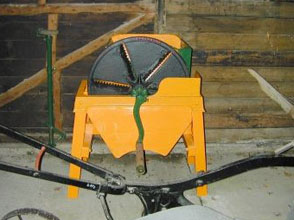

The Owen Barn named after Tom Owen, one of the founder members of the society, now houses many artefacts restored by members of the society. A sand-blaster, housed elsewhere on the site, sprays sand under high pressure from a gun. Rusty parts of machinery are enclosed in a sealed cabinet and the gun, hand held by long-arm rubber gloves fixed in the side of the cabinet, is used to blast the rust from the parts of the machine. Often the original colours can be identified under protected parts of the machinery and the item can then be painted in near-to original colours. One unusual item in the Owen Barn is a very large hand driven wheel that we think was used to drive a woodworking lathe via a flat belt. This would have been used prior to the introduction of electric motors probably in the early part of the nineteenth century.
The Pottery, operated by volunteers, demonstrates some of the skills used in the creation of ceramics. Demonstrations include throwing pots on the wheel, glazing items for Raku firing which can result in some interesting effects, including metallic lustre and crackle glazes. There is the opportunity to have a go at a variety of activities including hand building using air drying clay which can be painted when dry.
On display is a basic momentum wheel which shows the principle behind its mechanism. These early, often homemade, wheels were used before electricity was available and some potters today still use similar wheels to throw pots as they feel more in control and they are much quieter than wheels with a motor drive.
Potteries were often established in villages to supply the locals with their needs of vessels, crockery, plaques, sculptures, bricks, tiles and special presents. Clay would have been dug from ridges in the Chiltern Hills, (which are remains of ancient rivers that once flowed across the chalk). This clay deposit often contains fragments of flint with sand and all these materials are used together for the formation of glazes to give pots their smooth and sometimes glossy surface. To fire the pots, wood from the local trees would have been burnt in kilns to fuse the clay and melt the glaze. The area was well supplied with trees to support this purpose.


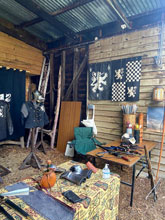
Entertainment varies during the Season and may include a display of arms and armour along with classic/vehicles, country/morris dancing, hand bell ringers, military vehicles and traction engines.